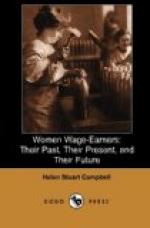In the first period of age, females pursuing gainful occupations are to males as one to three; in the second, one to six; and in the third, one to twelve. The actual increase over the numbers given in the census for 1860 is 1,551,288. The reasons for this almost incredible variation have already been suggested; and their operation became even stronger in the interval between that of 1870 and 1880. By this time methods were far more skilful and returns more minute, and thus the figures are to be accepted with more confidence than was possible with the earlier ones. The factory system, extending into almost every trade, brought about more and more differentiation of occupations, some two hundred of which were by 1880 open to women.
Comparing the rates of increase during the period between 1860 and 1870, women wage-earners had increased 19 per cent, the increase for men being but 6/97. Among the women, 6.7 per cent were engaged in agriculture, 33.4 in personal service, 7.3 in trade and transportation, and 16.5 in manufactures. In 1880 women engaged in gainful occupations formed 5.28 of the total population, and 14.68 of females over ten years of age. The present rate is not yet[18] determined; but while figures will not be accessible for some months to come, it is stated definitely that the increase will indicate nearer ten than five per cent.
The total number employed is given for this census as 2,647,157. The occupations are divided into four classes: first, agriculture; second, professional and personal services; third, trade and transportation; fourth, manufactures, mechanical and mining industries. In agriculture, 594,510 women were at work; in professional and personal services, this including domestic service, 1,361,295; trade and transportation, this including shop-girls, etc., had 59,364; while 631,988 were engaged in the last division of manufacturing, etc. Of girls from ten to fifteen years of age, agriculture had 135,862; professional and personal services, 107,830; trade, 2,547; and manufacturing, etc., 46,930. From sixteen to fifty-nine years of age there were in agriculture 435,920; in professional and personal services, 1,215,189; trade and transportation, 54,849; and manufacturing, etc., 577,157. From sixty years and upward the four classes were divided as follows: Agriculture, 22,728; professional, etc., 38,276; trade, etc., 1,968; and manufacturing, etc., 7,901.
Even for this record numbers must be added, since many women work at home and make no return of the trade they have chosen, while many others are held by pride from admitting that they work at all. But the addition of a hundred thousand for the entire country would undoubtedly cover this discrepancy in full; nor are these numbers too large, though it is impossible to more than approximate them.




